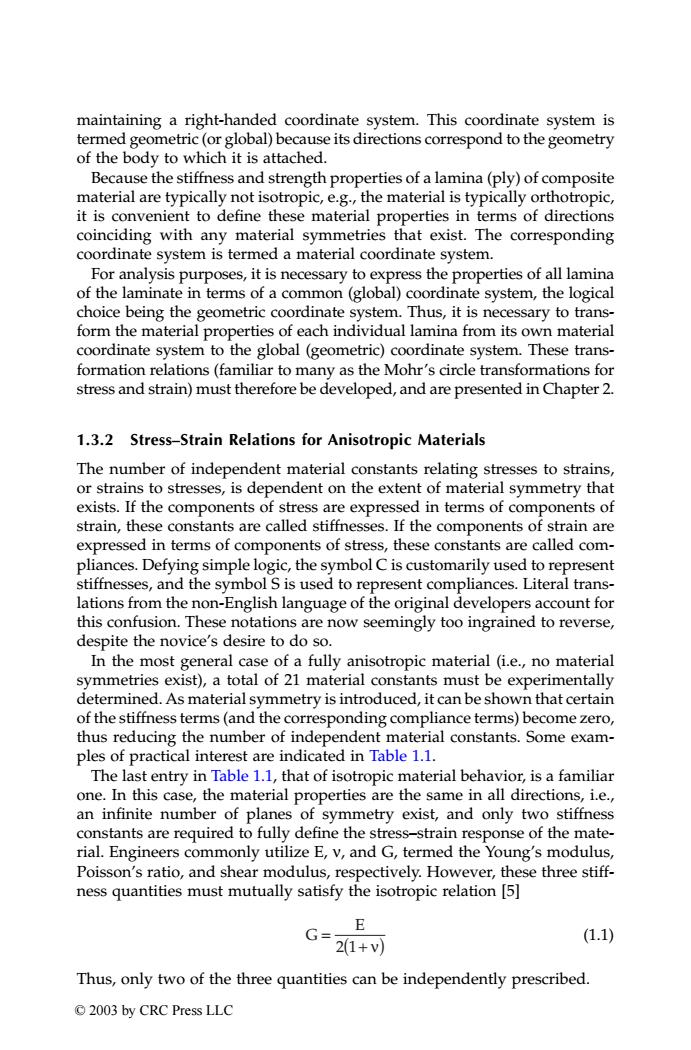正在加载图片...

maintaining a right-handed coordinate system.This coordinate system is termed geometric(or global)because its directions correspond to the geometry of the body to which it is attached. Because the stiffness and strength properties of a lamina(ply)of composite material are typically not isotropic,e.g.,the material is typically orthotropic, it is convenient to define these material properties in terms of directions coinciding with any material symmetries that exist.The corresponding coordinate system is termed a material coordinate system. For analysis purposes,it is necessary to express the properties of all lamina of the laminate in terms of a common (global)coordinate system,the logical choice being the geometric coordinate system.Thus,it is necessary to trans- form the material properties of each individual lamina from its own material coordinate system to the global(geometric)coordinate system.These trans- formation relations(familiar to many as the Mohr's circle transformations for stress and strain)must therefore be developed,and are presented in Chapter 2. 1.3.2 Stress-Strain Relations for Anisotropic Materials The number of independent material constants relating stresses to strains, or strains to stresses,is dependent on the extent of material symmetry that exists.If the components of stress are expressed in terms of components of strain,these constants are called stiffnesses.If the components of strain are expressed in terms of components of stress,these constants are called com- pliances.Defying simple logic,the symbol C is customarily used to represent stiffnesses,and the symbol S is used to represent compliances.Literal trans- lations from the non-English language of the original developers account for this confusion.These notations are now seemingly too ingrained to reverse, despite the novice's desire to do so. In the most general case of a fully anisotropic material (i.e.,no material symmetries exist),a total of 21 material constants must be experimentally determined.As material symmetry is introduced,it can be shown that certain of the stiffness terms(and the corresponding compliance terms)become zero, thus reducing the number of independent material constants.Some exam- ples of practical interest are indicated in Table 1.1. The last entry in Table 1.1,that of isotropic material behavior,is a familiar one.In this case,the material properties are the same in all directions,i.e., an infinite number of planes of symmetry exist,and only two stiffness constants are required to fully define the stress-strain response of the mate- rial.Engineers commonly utilize E,v,and G,termed the Young's modulus, Poisson's ratio,and shear modulus,respectively.However,these three stiff- ness quantities must mutually satisfy the isotropic relation [5] G= E (1.1) 2(1+v) Thus,only two of the three quantities can be independently prescribed. @2003 by CRC Press LLCmaintaining a right-handed coordinate system. This coordinate system is termed geometric (or global) because its directions correspond to the geometry of the body to which it is attached. Because the stiffness and strength properties of a lamina (ply) of composite material are typically not isotropic, e.g., the material is typically orthotropic, it is convenient to define these material properties in terms of directions coinciding with any material symmetries that exist. The corresponding coordinate system is termed a material coordinate system. For analysis purposes, it is necessary to express the properties of all lamina of the laminate in terms of a common (global) coordinate system, the logical choice being the geometric coordinate system. Thus, it is necessary to transform the material properties of each individual lamina from its own material coordinate system to the global (geometric) coordinate system. These transformation relations (familiar to many as the Mohr’s circle transformations for stress and strain) must therefore be developed, and are presented in Chapter 2. 1.3.2 Stress–Strain Relations for Anisotropic Materials The number of independent material constants relating stresses to strains, or strains to stresses, is dependent on the extent of material symmetry that exists. If the components of stress are expressed in terms of components of strain, these constants are called stiffnesses. If the components of strain are expressed in terms of components of stress, these constants are called compliances. Defying simple logic, the symbol C is customarily used to represent stiffnesses, and the symbol S is used to represent compliances. Literal translations from the non-English language of the original developers account for this confusion. These notations are now seemingly too ingrained to reverse, despite the novice’s desire to do so. In the most general case of a fully anisotropic material (i.e., no material symmetries exist), a total of 21 material constants must be experimentally determined. As material symmetry is introduced, it can be shown that certain of the stiffness terms (and the corresponding compliance terms) become zero, thus reducing the number of independent material constants. Some examples of practical interest are indicated in Table 1.1. The last entry in Table 1.1, that of isotropic material behavior, is a familiar one. In this case, the material properties are the same in all directions, i.e., an infinite number of planes of symmetry exist, and only two stiffness constants are required to fully define the stress–strain response of the material. Engineers commonly utilize E, ν, and G, termed the Young’s modulus, Poisson’s ratio, and shear modulus, respectively. However, these three stiffness quantities must mutually satisfy the isotropic relation [5] (1.1) Thus, only two of the three quantities can be independently prescribed. G E = 2 1( ) + ν TX001_ch01_Frame Page 7 Saturday, September 21, 2002 4:47 AM © 2003 by CRC Press LLC